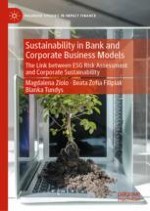2021 | OriginalPaper | Chapter
2. Sustainability Impact on Business Models
Author : Beata Zofia Filipiak
Published in: Sustainability in Bank and Corporate Business Models
Publisher: Springer International Publishing
Activate our intelligent search to find suitable subject content or patents.
Select sections of text to find matching patents with Artificial Intelligence. powered by
Select sections of text to find additional relevant content using AI-assisted search. powered by
